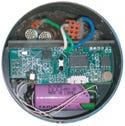Neurochip Links Damaged Brain Connections
January 1, 2007
R&D DIGEST
|
A neurochip helps relay neural activity from one site to another after the brain has been damaged. |
An implantable chip might be able to bridge weak pathways in the brain, aiding patients who suffer from paralysis or the effects of a stroke. The battery-powered device constantly monitors neural activity in one site of the brain and relays it, via electrical stimulation, to a neighboring site. This process could form the basis of an artificial connection between the brain and the spinal cord, for example, by teaching the brain to make up for weak connections.
“We wanted to develop a device that could continuously interact with the brain, 24 hours a day, because we're interested in developing neural prostheses,” explains Andrew Jackson, PhD, who carried out research on the device as a senior research fellow in the University of Washington (Seattle) physiology and biophysics department. Jackson is now a research associate in the school of neurology, neurobiology, and psychiatry at the University of Newcastle upon Tyne (UK).
The neurochip created by Jackson and his team has two circuit boards, a battery, and electrode connections, all housed in a 6-cm-diam titanium casing. The electronics consist of two programmable system-on-chips, which allow flexible analog and digital input and output with low power consumption. When the device is placed on a monkey's head, the animal continues normal behavior. Data are recorded to a chip with 16-Mb nonvolatile RAM. The data are then downloaded offline using an infrared link. The device also has a constant-current source to electrically stimulate neurons.
|
The circuit boards must be even smaller for next-generation devices. |
Other researchers working on the project at the University of Washington include Jaideep Mavoori, PhD, who developed the device for his doctoral thesis, and Eberhard Fetz, PhD, professor of physiology and biophysics. One of their recent studies, published in the November issue of the journal Nature, showed that continuously operating artificial connections between two sites in the motor cortex caused the underlying brain circuitry to reorganize. This strengthens the neural pathway between the connected sites, which could be important for recovering from a stroke or a spinal cord injury. The researchers think that neural prostheses might help to rehabilitate patients by training other brain circuits to take over the functions of damaged pathways.
According to Jackson, radio telemetry systems can be used as an alternative to their device. But, he says, those systems often experience limited bandwidth and range, and have high power consumption. Future designs of the neurochip will integrate multiple channels for recording and stimulation. Shrinking device size and reducing power consumption are other possibilities. “Ultimately, I would like to move toward a totally subcutaneous implant, powered wirelessly or even harnessing power from surrounding biological tissue,” says Jackson. “More generally, a major issue for the field of neural prosthetics is to design better electrodes at the interface between the electronics and neural tissue. Current methods are not yet really suitable for long-term implantation.” The researchers aren't directly working on this issue, but they may collaborate with groups that are trying new strategies to interface with the nervous system.
Jackson will continue to work on the chip at the University of Newcastle upon Tyne, where he hopes to implant artificial connections between two different areas in the brain, as opposed to between two sites within the same area. He'll also be collaborating with Fetz's group in Washington to further develop the device.
Grants from the National Institutes of Health, the Office of Naval Research, and the University of Washington Royalty Fund supported the work.
Copyright ©2007 Medical Device & Diagnostic Industry
About the Author(s)
You May Also Like




